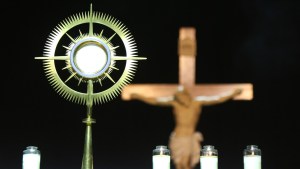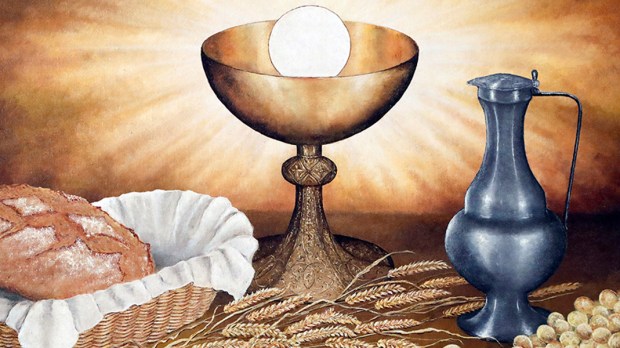On Corpus Christi, the Solemnity of the Body and Blood of Christ, celebrated Thursday in most of the world and this Sunday in the United States, Jesus Christ doesn’t just tell us that we are blessed and strong.
He shows us.
Jesus shows the disciples that they can do nothing alone. But with him, they can do amazing things.
In Sunday’s Gospel, Jesus starts out showing and not just telling.
When crowds gathered around him in a deserted spot, he “spoke to the crowd about the kingdom of God,” but also showed them: “he healed those who needed to be cured.”
But then he wants to show them — and his Apostles — even more. At suppertime, the Apostles want to send the crowds away to eat. Jesus wants them to stay. They can’t imagine how they could possibly feed everybody with just five loaves and two fish.
Jesus takes over. He has the apostles seat the crowd in groups of 50, then he blesses the bread and breaks it, and passes it to the disciples who bring it to each group.
You can picture the scene: The disciples keep coming back to Jesus and finding more and more food which they keep bringing out to the crowds.
The lesson is clear: Left to themselves, the Apostles can barely feed themselves. Working together, and returning to Jesus again and again, they can feed the multitudes.
“They all ate and were satisfied,” says the Gospel. “And when the leftover fragments were picked up, they filled twelve wicker baskets.”
Jesus did the same thing with wheat and grapes.
This is exactly what happens in the Eucharist, which, significantly, is made up of bread and wine.
The importance of bread and wine in the Bible reach back long before the Eucharist. In the first reading, a mysterious figure – Melchizedek, the first person in the Bible called a priest — offers bread and wine to the future Abraham, along with a blessing.
He could have offered nuts and fruit with his blessing. Then, his offering would have said, “God wants you to survive.” Instead, he offered bread and wine.
These are not foods you scavenge for; they are foods that require imagination, intelligence, communal effort, and lots of time to make. You don’t get bread without planting, nurturing and harvesting wheat, threshing it, grinding it, making dough, adding yeast, and baking it. You need technology and you need help. It’s the same with wine. You need baskets and storehouses for harvesters, vats and barrels for vintners.
Not only does each loaf and each cup of wine represent wheat and grapes taken from far and wide, each loaf and chalice represent a community of workers.
This is what Jesus is showing with the Eucharist: Like the bread and wine, the body of Christ, the Church, will need a community.
Jesus is like the old man in the fable.
Aesop tells the tale of a group of adult sons who kept arguing with each other. Their father warned them that their bickering would be their undoing. His words made no impact on them. So he decided to show them, instead.
One day when they were seething silently, a sullen pause in their latest argument, the father brought them a bunch of sticks tied together. He gave it to each and asked them to break it. None of them could.
So he untied the sticks and handed one to each son. They broke them easily.
“My sons,” said the father, “do you not see how certain it is that if you agree with each other and help each other, it will be impossible for your enemies to injure you? But if you are divided among yourselves, you will be no stronger than a single stick in that bundle.”
But then Jesus adds to the lesson: We are not just strong like a team working together, we’re strong like a team working with God.
In the first reading, written around 53 AD, shortly after the death of Jesus, Paul describes the Eucharist: “The Lord Jesus, on the night he was handed over, took bread, and, after he had given thanks, broke it and said, ‘This is my body that is for you.’”
Jesus had told the crowds after the multiplication of the loaves, in John’s version of the story, that they must “eat my flesh and drink my blood” to have eternal life.
Here, Paul shows us what that will look like: In the Eucharist, Jesus turns the bread and wine into his very body, blood, soul and divinity.
This is another object lesson. By having us eat his very body and blood, Jesus is telling us that he wants to be united so intimately with us that he is himself the life that his followers share.
Together, we are greater than the sum of our parts. Together with Jesus, we are invincible.

Read more:
How I began to believe that the Eucharist really is Jesus

